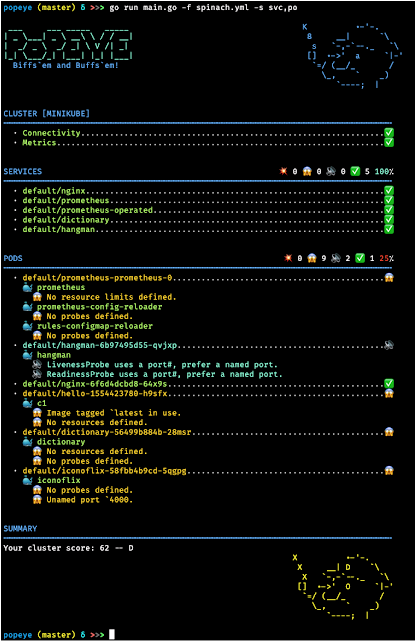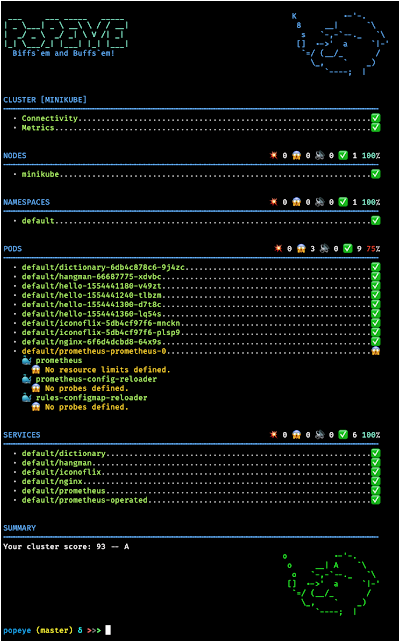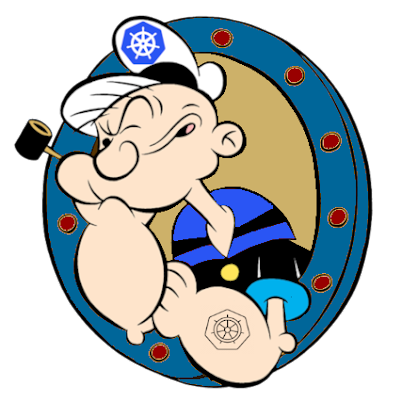Popeye – A Kubernetes Cluster Resource Sanitizer
Popeye – A Kubernetes Cluster Sanitizer
Popeye is a utility that scans live Kubernetes cluster and reports potential issues with deployed resources and configurations. It sanitizes your cluster based on what’s deployed and not what’s sitting on disk. By scanning your cluster, it detects misconfigurations and helps you to ensure that best practices are in place, thus preventing future headaches. It aims at reducing the cognitive overload one faces when operating a Kubernetes cluster in the wild. Furthermore, if your cluster employs a metric-server, it reports potential resources over/under allocations and attempts to warn you should your cluster run out of capacity.
Popeye is a readonly tool, it does not alter any of your Kubernetes resources in any way!
Installation
Popeye is available on Linux, OSX and Windows platforms.
-
Binaries for Linux, Windows and Mac are available as tarballs in the release page.
-
For OSX/Unit using Homebrew/LinuxBrew
brew install derailed/popeye/popeye -
Building from source Popeye was built using go 1.12+. In order to build Popeye from source you must:
-
Clone the repo
-
Add the following command in your go.mod file
replace (
github.com/derailed/popeye => MY_POPEYE_CLONED_GIT_REPO
) -
Build and run the executable
go run main.go
Quick recipe for the impatient:
# Clone outside of GOPATH
git clone https://github.com/derailed/popeye
cd popeye
# Build and install
go install
# Run
popeye -
PreFlight Checks
-
Popeye uses 256 colors terminal mode. On `Nix system make sure TERM is set accordingly.
export TERM=xterm-256color
Sanitizers
Popeye scans your cluster for best practices and potential issues. Currently, Popeye only looks at nodes, namespaces, pods and services. More will come soon! We are hoping Kubernetes friends will pitch’in to make Popeye even better.
The aim of the sanitizers is to pick up on misconfigurations, i.e. things like port mismatches, dead or unused resources, metrics utilization, probes, container images, RBAC rules, naked resources, etc…
Popeye is not another static analysis tool. It runs and inspect Kubernetes resources on live clusters and sanitize resources as they are in the wild!
Here is a list of some of the available sanitizers:
| Resource | Sanitizers | Aliases | |
|---|---|---|---|
| Node | no | |
| Conditions ie not ready, out of mem/disk, network, pids, etc | |||
| Pod tolerations referencing node taints | |||
| CPU/MEM utilization metrics, trips if over limits (default 80% CPU/MEM) | |||
| Namespace | ns | |
| Inactive | |||
| Dead namespaces | |||
| Pod | po | |
| Pod status | |||
| Containers statuses | |||
| ServiceAccount presence | |||
| CPU/MEM on containers over a set CPU/MEM limit (default 80% CPU/MEM) | |||
| Container image with no tags | |||
Container image using latest tag | |||
| Resources request/limits presence | |||
| Probes liveness/readiness presence | |||
| Named ports and their references | |||
| Service | svc | |
| Endpoints presence | |||
| Matching pods labels | |||
| Named ports and their references | |||
| ServiceAccount | sa | |
| Unused, detects potentially unused SAs | |||
| Secrets | sec | |
| Unused, detects potentially unused secrets or associated keys | |||
| ConfigMap | cm | |
| Unused, detects potentially unused cm or associated keys | |||
| Deployment | dp, deploy | |
| Unused, pod template validation, resource utilization | |||
| StatefulSet | sts | |
| Unsed, pod template validation, resource utilization | |||
| DaemonSet | ds | |
| Unsed, pod template validation, resource utilization | |||
| PersistentVolume | pv | |
| Unused, check volume bound or volume error | |||
| PersistentVolumeClaim | pvc | |
| Unused, check bounded or volume mount error | |||
| HorizontalPodAutoscaler | hpa | |
| Unused, Utilization, Max burst checks | |||
| PodDisruptionBudget | ||
| Unused, Check minAvailable configuration | pdb | ||
| ClusterRole | ||
| Unused | cr | ||
| ClusterRoleBinding | ||
| Unused | crb | ||
| Role | ||
| Unused | ro | ||
| RoleBinding | ||
| Unused | rb | ||
| Ingress | ||
| Valid | ing | ||
| NetworkPolicy | ||
| Valid | np | ||
| PodSecurityPolicy | ||
| Valid | psp |
You can also see the full list of codes
Save the report
To save the Popeye report to a file pass the --save flag to the command. By default it will create a temp directory and will store the report there, the path of the temp directory will be printed out on STDOUT. If you have the need to specify the output directory for the report, you can use the environment variable POPEYE_REPORT_DIR. By default, the name of the output file follow the following format : sanitizer_<cluster-name>_<time-UnixNano>.<output-extension> (e.g. : “sanitizer-mycluster-1594019782530851873.html”). If you have the need to specify the output file name for the report, you can pass the --output-file flag with the filename you want as parameter.
Example to save report in working directory:
$ POPEYE_REPORT_DIR=$(pwd) popeye --saveExample to save report in working directory in HTML format under the name “report.html” :
$ POPEYE_REPORT_DIR=$(pwd) popeye --save --out html --output-file report.htmlSave the report to S3
You can also save the generated report to an AWS S3 bucket (or another S3 compatible Object Storage) with providing the flag --s3-bucket. As parameter you need to provide the name of the S3 bucket where you want to store the report. To save the report in a bucket subdirectory provide the bucket parameter as bucket/path/to/report.
Underlying the AWS Go lib is used which is handling the credential loading. For more information check out the official documentation.
Example to save report to S3:
popeye --s3-bucket=NAME-OF-YOUR-S3-BUCKET/OPTIONAL/SUBDIRECTORY --out=jsonIf AWS sS3 is not your bag, you can further define an S3 compatible storage (OVHcloud Object Storage, Minio, Google cloud storage, etc…) using s3-endpoint and s3-region as so:
popeye --s3-bucket=NAME-OF-YOUR-S3-BUCKET/OPTIONAL/SUBDIRECTORY --s3-region YOUR-REGION --s3-endpoint URL-OF-THE-ENDPOINTRun public Docker image locally
You don’t have to build and/or install the binary to run popeye: you can just run it directly from the official docker repo on DockerHub. The default command when you run the docker container is popeye, so you just need to pass whatever cli args are normally passed to popeye. To access your clusters, map your local kube config directory into the container with -v :
docker run --rm -it \
-v $HOME/.kube:/root/.kube \
derailed/popeye --context foo -n barRunning the above docker command with --rm means that the container gets deleted when popeye exits. When you use --save, it will write it to /tmp in the container and then delete the container when popeye exits, which means you lose the output. To get around this, map /tmp to the container’s /tmp. NOTE: You can override the default output directory location by setting POPEYE_REPORT_DIR env variable.
You can use Popeye standalone or using a spinach yaml config to tune the sanitizer. Details about the Popeye configuration file are below.
# Dump version info
popeye version
# Popeye a cluster using your current kubeconfig environment.
popeye
# Popeye uses a spinach config file of course! aka spinachyaml!
popeye -f spinach.yml
# Popeye a cluster using a kubeconfig context.
popeye --context olive
# Stuck?
popeye helpOutput Formats
Popeye can generate sanitizer reports in a variety of formats. You can use the -o cli option and pick your poison from there.
| Format | Description | Default | Credits |
|---|---|---|---|
| standard | The full monty output iconized and colorized | yes | |
| jurassic | No icons or color like it’s 1979 | ||
| yaml | As YAML | ||
| html | As HTML | ||
| json | As JSON | ||
| junit | For the Java melancholic | ||
| prometheus | Dumps report a prometheus scrappable metrics | dardanel | |
| score | Returns a single cluster sanitizer score value (0-100) | kabute |
The SpinachYAML Configuration
A spinach.yml configuration file can be specified via the -f option to further configure the sanitizers. This file may specify the container utilization threshold and specific sanitizer configurations as well as resources that will be excluded from the sanitization.
NOTE: This file will change as Popeye matures!
Under the excludes key you can configure to skip certain resources, or certain checks by code. Here, resource types are indicated in a group/version/resource notation. Example: to exclude PodDisruptionBugdets, use the notation policy/v1/poddisruptionbudgets. Note that the resource name is written in the plural form and everything is spelled in lowercase. For resources without an API group, the group part is omitted (Examples: v1/pods, v1/services, v1/configmaps).
A resource is identified by a resource kind and a fully qualified resource name, i.e. namespace/resource_name.
For example, the FQN of a pod named fred-1234 in the namespace blee will be blee/fred-1234. This provides for differentiating fred/p1 and blee/p1. For cluster wide resources, the FQN is equivalent to the name. Exclude rules can have either a straight string match or a regular expression. In the latter case the regular expression must be indicated using the rx: prefix.
NOTE! Please be careful with your regex as more resources than expected may get excluded from the report with a loose regex rule. When your cluster resources change, this could lead to a sub-optimal sanitization. Once in a while it might be a good idea to run Popeye „configless“ to make sure you will recognize any new issues that may have arisen in your clusters…
Here is an example spinach file as it stands in this release. There is a fuller eks and aks based spinach file in this repo under spinach. (BTW: for new comers into the project, might be a great way to contribute by adding cluster specific spinach file PRs…)
Alternatively, Popeye is containerized and can be run directly in your Kubernetes clusters as a one-off or CronJob.
Here is a sample setup, please modify per your needs/wants. The manifests for this are in the k8s directory in this repo.
kubectl apply -f k8s/popeye/ns.yml && kubectl apply -f k8s/popeye---
apiVersion: batch/v1
kind: CronJob
metadata:
name: popeye
namespace: popeye
spec:
schedule: "* */1 * * *" # Fire off Popeye once an hour
concurrencyPolicy: Forbid
jobTemplate:
spec:
template:
spec:
serviceAccountName: popeye
restartPolicy: Never
containers:
- name: popeye
image: derailed/popeye
imagePullPolicy: IfNotPresent
args:
- -o
- yaml
- --force-exit-zero
- true
resources:
limits:
cpu: 500m
memory: 100MiThe --force-exit-zero should be set to true. Otherwise, the pods will end up in an error state. Note that popeye exits with a non-zero error code if the report has any errors.
Popeye got your RBAC!
In order for Popeye to do his work, the signed-in user must have enough RBAC oomph to get/list the resources mentioned above.
Sample Popeye RBAC Rules (please note that those are subject to change.)
---
# Popeye ServiceAccount.
apiVersion: v1
kind: ServiceAccount
metadata:
name: popeye
namespace: popeye
---
# Popeye needs get/list access on the following Kubernetes resources.
apiVersion: rbac.authorization.k8s.io/v1
kind: ClusterRole
metadata:
name: popeye
rules:
- apiGroups: [""]
resources:
- configmaps
- deployments
- endpoints
- horizontalpodautoscalers
- namespaces
- nodes
- persistentvolumes
- persistentvolumeclaims
- pods
- secrets
- serviceaccounts
- services
- statefulsets
verbs: ["get", "list"]
- apiGroups: ["rbac.authorization.k8s.io"]
resources:
- clusterroles
- clusterrolebindings
- roles
- rolebindings
verbs: ["get", "list"]
- apiGroups: ["metrics.k8s.io"]
resources :
- pods
- nodes
verbs: ["get", "list"]
---
# Binds Popeye to this ClusterRole.
apiVersion: rbac.authorization.k8s.io/v1
kind: ClusterRoleBinding
metadata:
name: popeye
subjects:
- kind: ServiceAccount
name: popeye
namespace: popeye
roleRef:
kind: ClusterRole
name: popeye
apiGroup: rbac.authorization.k8s.ioScreenshots
Cluster D Score
👀 A Kubernetes cluster resource sanitizer (20)”>
Cluster A Score
👀 A Kubernetes cluster resource sanitizer (21)”>
Report Morphology
The sanitizer report outputs each resource group scanned and their potential issues. The report is color/emoji coded in term of Sanitizer severity levels:
| Level | Icon | Jurassic | Color | Description |
|---|---|---|---|---|
| Ok | ✅ | OK | Green | Happy! |
| Info | | I | BlueGreen | FYI |
| Warn | | W | Yellow | Potential Issue |
| Error | | E | Red | Action required |
The heading section for each scanned Kubernetes resource provides a summary count for each of the categories above.
The Summary section provides a Popeye Score based on the sanitization pass on the given cluster.
Known Issues
This initial drop is brittle. Popeye will most likely blow up when…
- You’re running older versions of Kubernetes. Popeye works best with Kubernetes 1.13+.
- You don’t have enough RBAC oomph to manage your cluster (see RBAC section)
Disclaimer
This is work in progress! If there is enough interest in the Kubernetes community, we will enhance per your recommendations/contributions. Also if you dig this effort, please let us know that too!
ATTA Girls/Boys!
Popeye sits on top of many of open source projects and libraries. Our sincere appreciations to all the OSS contributors that work nights and weekends to make this project a reality!
Contact Info
- Email: [email protected]
- Twitter: @kitesurfer
A considerable amount of time and effort goes into maintaining this website, creating backend automation and creating new features and content for you to make actionable intelligence decisions. Everyone that supports the site helps enable new functionality.
If you like the site, please support us on Patreon using the button below

To keep up to date follow us on the below channels.







